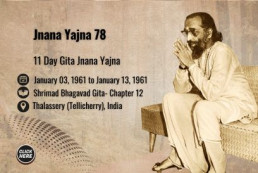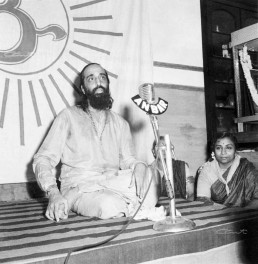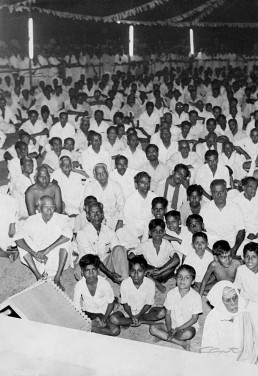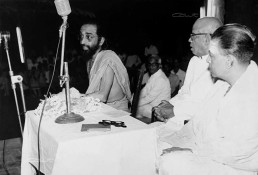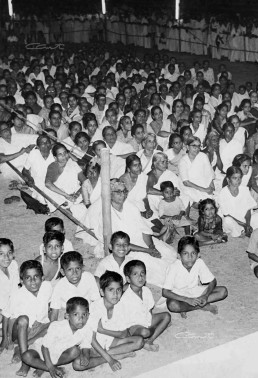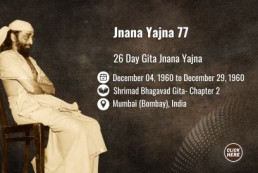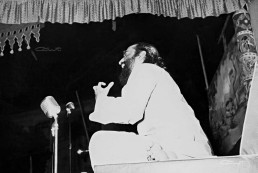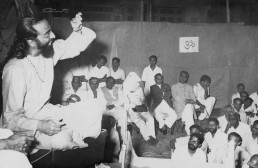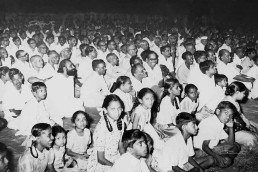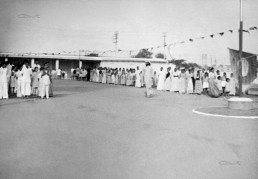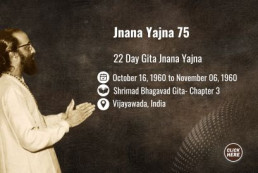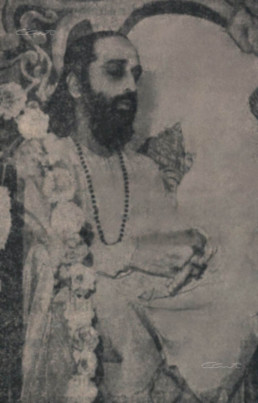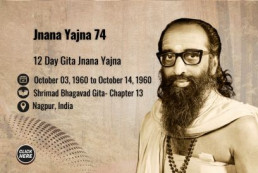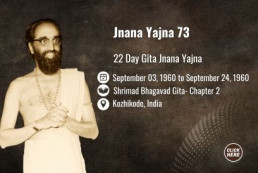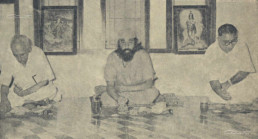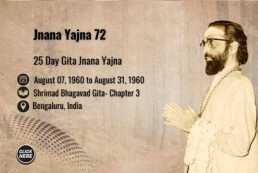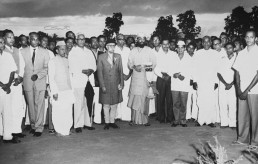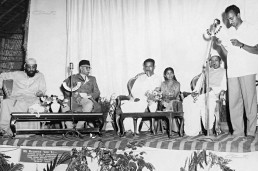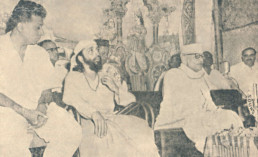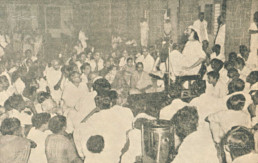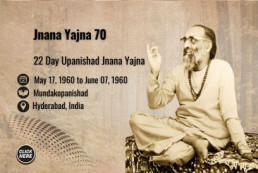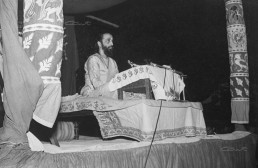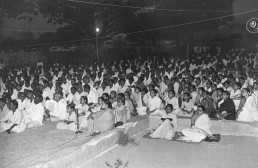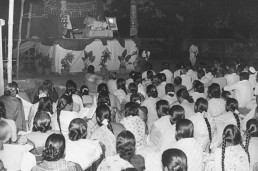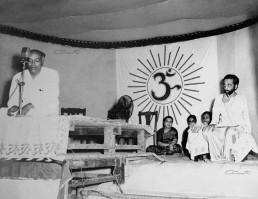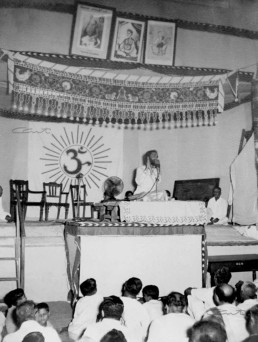Jnana Yajna 78
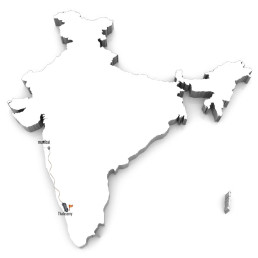
Jnana Yajna 78

Year & Dates:
January 03, 1961 to January 13, 1961

Yajna Topic:
Shrimad Bhagavad Gita- Chapter 12

Place:
Thalassery (Tellicherry), India.
An ancient trading center with a picturesque coastline, Thalassery, was in a jubilant spirit. At last, Pujya Gurudev was going to roar the message of scriptures in His 78th Jnana Yajna to the seekers in that town. The focus was going to be on Chapter 12 of Shrimad Bhagavad Gita, on the love for the Highest.
The Yajnashala: Outside the local temple for Lord Krishna, the yajnashala spruced with orange and white streamers stood ready for the happy audience. Pujya Gurudev was welcomed with flowers and lamps in a traditional, melodious style with naadasvara and caparisoned elephants leading the procession.
The Inauguration: Invoking Bhagavan Krishna’s Grace with prayers, the yajna commenced. Making the trip from Bengaluru in spite of health issues with great regard for Pujya Gurudev, Sri. V.P. Menon, a weathered statesman of Kerala, inaugurated the Gita Jnana Yajna.
The Gita Tune-Up for Higher Efficiency
From the Inaugural Message: Expressing how religion and faith in God build a strong society and enhance the welfare of a nation, Sri V.P. Menon stated that, “A man, or society without a
religion is like a horse without reins. In the Hindu tradition of thought, our Philosophy gives us not only an ideal and a perfect way of life but also prescribes the means and the method by
which individuals irrespective of their basic qualities can reach that state of perfect living. This is most important at the present time when there is so much misconception about Religion and its
moral values.”
Honored Attendee: On a nostalgic note, Sri Vishwanatha Iyer, the District Judge who presided over the yajna, recalled the vibrant, fun-loving youth of Pujya Gurudev. Knowing Pujya Gurudev from schooldays, He shared that even from that early age, the extraordinary brilliance in Pujya Gurudev’s eyes set Him apart from others. Pujya Gurudev being the pride of Kerala and a great champion of the Gita, it was an honor to preside over His first Gita Jnana Yajna at Thalassery, acknowledged the district judge.
From Pujya Gurudev’s Inaugural address: Pujya Gurudev first clarified that He had no mystic powers and was no divine messenger. He said unequivocally: ”We should not merely accept its (Gita’s) teachings simply because Lord Krishna is quoted as having said this and that. But we should merely treat it as the words of a Gopal or cowherd speaking to a frustrated and dilapidated prince Arjuna and seek to analyze the basic truths contained in it and study its pros and cons without any prejudice.”
“The lessons of the Gita bring home to us the relationship between the mind and body controlled by the intellect in the most efficient manner. The mind has to be tuned even as the engine of an automobile has to be for better efficiency and performance.”
The Audience: Impressed by Pujya Gurudev’s depth of knowledge and clarity of expression, the devoted audience of Thalassery listened with great faith. They understood that without decrying the distractions of the world, they could develop the ability to concentrate on the divine, as guided by Pujya Gurudev.
For Reflection: Through those crucial post-independence years in India, when Vedic scriptures were considered irrelevant to secular progress, Pujya Gurudev emphasized repeatedly that external progress is sustainable only with internal spiritual reconditioning.
Photo Gallery

“Think,” Says Pujya Gurudev
“Free from dependence” (Anapekshah):- A true devotee no more depends upon either the objects of the world outside, or their pattern or their relationship with himself. An ordinary man discovers his peace and joy only in the world-of-objects available for him, their conditions and arrangements around him. When the right type of objects is in the right pattern courting him favorably, a man of the world feels he is temporarily thrilled and joyous. But a devotee is completely independent of the world outside and he draws his inspiration, equanimity and joyous ecstasy from a deeper source within himself.
“Who is pure” (Suci):- Dirt has no place anywhere within or without a true devotee. One who is aspiring to reach perfection will necessarily be so well-disciplined physically that he will be clean not only in his behavior but also in his relationship with others and even in the very condition and arrangement of his belongings around him. It is very well known that the condition of a man’s table or shelf and the cleanness of his apparel can give us a great insight into the mental nature, discipline and culture of that man. Great emphasis has been laid in India on this physical purity not only in the person of the man but his contacts in the world. Without external purity internal purification will become but a vague dream, an idle hope, a despairing vision.
From Tyagi Magazine
Don’t make this fundamental mistake!
Liberation from agitation stems from realizing joy resides within, not in external objects. This understanding eradicates attachment, envy, and fear, fostering a state of contentment and freedom from harmful desires. Not realizing this is the fundamental mistake we all make. A devotee, devoid of vasanas, finds joy within and is cherished for their inner peace and detachment.
Jnana Yajna 77
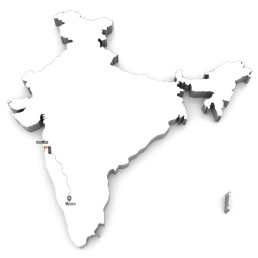
Jnana Yajna 77

Year & Dates:
December 04, 1960 to December 29, 1960

Yajna Topic:
Shrimad Bhagavad Gita- Chapter 2

Place:
Mumbai (Bombay), India.
Seeing an airport lounge overflow with a huge crowd of enthusiastic devotees rushing to welcome Pujya Gurudev when He landed in any airport was a common occurrence. The story was the same in railway stations too. Pujya Gurudev began gently discouraging such gatherings; thus, when He landed on December 3, 1960, in Mumbai, only a small group of yajna committee members, Chinmaya Mission office-bearers, and a few devotees, happy to have His permission, welcomed Him. After a caring word for each one, He shifted His attention to the preparations for the 77th Jnana Yajna in Mumbai.
The Yajnashala: The venue for the Gita Jnana Yajna was the sprawling Indian Gymkhana Grounds near Matunga, Mumbai, with a Purna Kumbha welcome after a joyful procession from Napoo Gardens.
The Inauguration: It was the honor given to Prof. D. D. Vadekar, Poona University on the evening of December 4, 1960.
Increasing Yajnas, Mindful Modifications
From the Inaugural Message: A longtime admirer of Pujya Gurudev, the academically eminent Prof. Vadekar said that the Gita was the gospel of life and the distilled essence of the spiritual literature of India.
The Chief Guest: Known for his great contribution to Yoga, Swami Kuvalayananda of Kaivalyadham, Mumbai, who was close to 80 years old, admired Pujya Gurudev for His tireless service in bring Srimad Bhagavad Gita to the forefront of modern minds. Calling Pujya Gurudev as a spiritually advanced Guru , Swami Kuvalayananda noted, “Swami Chinmayananda, for all his black hair, is older!”
From Pujya Gurudev’s Inaugural address: Thanking both the professor and the yogi for their assurance about the grandeur of the Gita, Pujya Gurudev began, “I am here to represent the man on the street. We have all heard that the Gita is a great book, a scripture…contains wonderful advice, gives an ideal to pursue, a goal in life to live etc. Can Gita give us strength to bear nobly our Cross? Can it give us the courage to suffer our bitterness, agitations, despairs, despondencies? If a study of Gita can help us even a little in these, certainly we will start its study right away.
“Our text for the current Yajna is chapter 2. In short, it is the ‘index’ for the Gita, and I assure you that there will be a lot of real-drama in it!”
The Audience: They had listened the previous year to Bhagavad Gita chapter 3 from Pujya Gurudev, where He extolled the glory of action through Karma Yoga. In the pleasant Mumbai winter, thousands of Mumbai seekers filled the Gymkhana grounds, not wanting to miss the transcendent knowledge that Bhagavan Krishna was transmitting through Pujya Gurudev.
For Reflection: As 1960 came to an end, Pujya Gurudev slowly declutched the features of the yatras, havana, or laksharchana from His further yagnas. It was not that He considered such modes of Sadhana as no longer required. The groups were getting bigger, and Pujya Gurudev had delegated, with clear guidelines, such yatras and activities to the different Chinmaya Mission centers.
Meanwhile, Sandeepany Sadhanalaya in Mumbai was taking shape, and Pujya Gurudev devoted time to nourish its roots while carefully managing the demands of His increasing Jnana Yajnas.
Photo Gallery

“Think,” Says Pujya Gurudev
The Philosophy of a country like India in the Vedic period, may necessarily be Theistic, but it has its applications in all walks of life. If it fails in its all-round application, it cannot be a philosophy. A theory of life which has no universal application can only be appreciated as a noble opinion of an individual which may have its own limited application, but it can never be accepted as a philosophy.
In the entire scheme of Bhagawan’s arguments so far he has provided Arjuna with all the necessary arguments which a healthy intellect should discover for itself, before it can come to a reliable and dependable judgment upon the outer happenings. A mere spiritual consideration is not the last word in evaluating the material situations. Every challenge is to be estimated from the spiritual stand-point, from the intellectual stand-point or reason, from the emotional level of ethics and morality, and from the physical level of tradition and custom. If all these considerations without any contradiction in themselves indicated a solitary truth, that is surely then the Divine Path of judgment that one should at all costs take up.
From Tyagi Magazine
What causes Anger?
Failure to control the senses leads to a downward spiral: attachment to desires, followed by disappointment and anger. Anger clouds judgment, leading to delusion and forgetfulness of rationality, turning one into a mere creature driven by instincts, devoid of discernment.
Jnana Yajna 76
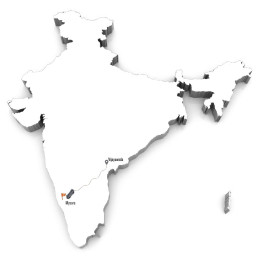
Jnana Yajna 76

Year & Dates:
November 11, 1960 to December 02, 1960

Yajna Topic:
Shrimad Bhagavad Gita- Chapter 13

Place:
Mysore, India.
The Vedantic Renaissance was in full steam across India. After painstaking efforts through 75 Jnana Yajnas, the Jnana Yajna scheme had taken a firm footing. The format was standardized while the attendance and spiritual aspirations kept ascending. The rationale behind including well-known personalities to inaugurate the Jnana Yajnas was to inspire the influential to become value-based role models in society. Pujya Gurudev did not really need the patronage of the big names. It was they who needed to be involved in the ongoing spiritual regeneration of the intelligentsia as well as the ignorant.
In the 108-yajna pilgrimage from hereon, let us turn the pages of each yajna to recognize the pattern and then pause to reflect on the subtle and significant..
The Yajnashala: Dasara Pavilion, festively decorated, and its brightly-lit, surrounding garden The Inauguration: By His Highness Maharaja Jaya Chamaraja Wadiyar Bahadur, Governor of Mysore on the evening of November 11. 1960
Sustaining Vision, Transparent Field
From the Governor’s Inaugural Message: “Swami Chinmayanandaji is doing great service carrying the message of the Geeta to the very doors of those who are too busy in the work-a-day world even to take a glance at this great book of perennial wisdom…”
“Of the 18 chapters of the Gita, the third and final group of six chapters commences with the 13th chapter which is termed the Kshetra-Kshetrajna-Vibhaga Yoga.It contains the entire metaphysics of the Gita…The chapter commences by telling us that this body is the kshetra or the field of operation for the Indwelling Spirit or Kshetrajna.”
Honored Attendee: Sri. Mali Mariyappa, Minister for Co-operation, who expressed the wish that humanity must rise above the narrow view of a selfish,ego-driven life
From Pujya Gurudev’s Inaugural address: “This sociological development of man could only be done by an intelligent and critical study of the philosophy of Geeta. The great principles enunciated therein are to be looked into from this point of view, of building up a healthier society than as a mere religious narrative…man is not only a materialist by nature: but has a spiritual background also. It is the spiritual background of ages that has sustained us till today.”
The Audience: Over 10,000 thronged the yajnashala to admire the “ forceful personality of Pujya Gurudev coupled with the rare characteristic of scholarship, oratory, and approach to the subject studded with convincing illustrations and anecdotes of everyday occurrences in life.”
The Yatra: 500 pilgrims had the Avabhrta Snaana in the holy Kaveri near Shree Ranga-pattana. Chanting the Gita and singing keertanas, they trekked up the sacred Yadugiri hill at Melkote which overlooks the Kaveri valley for darshan at two shrines – the temples for Lord Cheluvanarayana and Lord Yoganarasimha.
The Conclusion: Sri. B.D. Jatti, Chief Minister of Mysuru presided over the concluding ceremony on December 2nd at the Dasara Exhibition Building. Dr. M.L. Mariswamy, treasurer of the yajna committee, read the statement of receipts and expenditure; the yajna committee donated Re. 11,111 to support the upcoming Sandeepany Sadhanalaya.
For Reflection: Secular clarity is key for Spiritual upliftment – Pujya Gurudev ensured that the financial background of every Jnana Yajna is kept transparent to the public through the statement of accounts submitted to Usha monthly.
Photo Gallery

“Think,” Says Pujya Gurudev
Dwelling in the heart of all: If thus there is an Infinite Light of knowledge to be known-without which life is impossible; in the presence of which alone can all experience come to have a meaning and an existence then this Infinite Goal is certainly to be acquired and processed. When am I to seek? What pilgrimage must I take? Am I capable of making an expedition? Probably I am not in possession of it today as it must be something to be experienced yonder, in some unknown and impossible time and place. To negate all such misconceptions, the staggering truth has been vividly declared here, that this Infinite dwells in the hearts of all. Philosophically heart means that area in the mental zone from where the noble and pious thoughts spring forth. In an atmosphere of goodness when the intellect steadily contemplates upon that “Light” that lies beyond darkness the Absolute non-dual Self that exists, transcending all but at once immanent in its subtle all-pervading nature. It can be contacted and realized and, therefore, heart is considered as the dwelling place of the Self.
The Consciousness functioning in the seekers mind and intellect, If lived and experienced by Itself that must give the experience of the Infinite, just as by knowing the composition of a minute particle of salt, the entire world of Sodium Chloride is understood.
From Tyagi Magazine
Spiritual Growth Stunted?
Ever pondered the roadblocks hindering your spiritual growth? What’s causing this slowdown, and how can you overcome it? What solutions can one seek amidst these worldly distractions and find inner balance? Watch this video to tide over these blocks.
Jnana Yajna 75
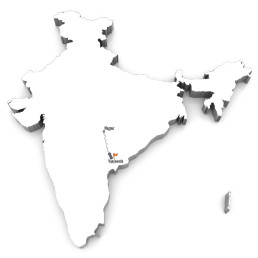
Jnana Yajna 75

Year & Dates:
October 16, 1960 to November 06, 1960

Yajna Topic:
Shrimad Bhagavad Gita- Chapter 3

Place:
Vijayawada, India.
Vijayawada, on the banks of the Krishna river in Andhra Pradesh, is famous for its sacred Kanaka Durga temple that overlooks the city from the Indrakeeladri hill. Its spiritual aspirants awaited Pujya Gurudev’s first Jnana Yajna in their city and had poured their hearts in erecting the yajnashala adorned in white and orange in the center of the Challapalli House premises. The dais with the Krishna-Arjuna Samvaad background and the prominent Om symbol stood ready for the Vedantic Master, as was the sanded floor with the palmyra mats for the sea of devotees.
The inauguration on the evening of October 16, 1960, was powerful because three spiritual stalwarts – Swami Pranavananda, Dr. Swami Gnanananda, and Pujya Gurudev Swami Chinmayananda graced the stage. Swami Pranavananda of Gudivada who taught Vedanta in Telugu and Sanskrit was the first to address the audience after Sri G. Subbaraju, the secretary of the yajna committee welcomed all.
Performing Work, Scientific and Divine
Swami Pranavananda first pointed out the ritualistic connotation of a yajna as oblations offered by householders in the sacrificial fire to please the gods. In comparison, he said, in the Gita Jnana Yajna, Pujya Gurudev was the yajna-karta as well as Adhyaksha, the preceptor; the gods who received the offering of knowledge were the seekers. Like the Om flag flying high in each yajna, he said the yajna’s purpose was to hoist Self-Knowledge in the hearts of the audience.
The scientist cum Vedantin, Dr. Swami Gnanananda, then spoke clarifying about the vision of scientists: “A true scientist recognises this divine presence, harmony in all his discoveries and the more he discovers the more he becomes constantly aware of His play.”
Starting on a humorous note, Pujya Gurudev observed that caught between the “champion of Sanaatana Dharma, Swami Pranavananda” and the very scientific (Dr.) Swami Gnanananda, between “jnana and pranava,” He was there to share the immortal words of Bhagavan Krishna in the Gita.
Apart from His forceful discourses on Karma Yoga since that evening, Pujya Gurudev taught Atma Bodha at 7 am in the mornings from October 21st. He expressed great reverence and admiration for its author – the spiritual missionary, prodigy and Advaitic Master Sri Adi Shankaracharya who re-established Hinduism in the face of atheistic challenges.
As the 75th yajna approached a fulfilling conclusion, Pujya Gurudev led the yatra to Machilipatnam and the sacred venue of Shivaganga nearby as a practical exercise in Karma Yoga. The yatra itself was a unique excursion with a dual viewpoint of science and spirituality. The devotees visited a pharmaceutical laboratory and a scientific equipment company; they had enlightening satsangs, avabruta snaana in the sea, darshan at Panduranga Mandir, the only temple in the state dedicated to Lord Panduranga Vittala in Chilakalapudi (a suburb of Machilipatnam), another invigorating satsang, and prayers at the powerful Jagatjanani temple in Sivaganga. A stopover at Pranavashram in Gudivada enabled all to also witness Pujya Gurudev’s reception by Swami Pranavananda.
Back in Vijayawada, in the final days of the 75th yajna, thousands of devotees were immersed in devotion while performing the Laksharchana of an attractive Bhagavan Krishna in the yajnashala.
In that glorious yajna where knowledge of action was understood and applied in divine outlets, Pujya Gurudev made the hearts of Vijayawada soar high like the Om flag above the yajnashala.
Photo Gallery

“Think,” Says Pujya Gurudev
Attachment becomes a clog or a painful chain on us only when it is extremely ego-centric. To the extent we work for larger schemes to bless a vast section of humanity, to that extent the attachment loses its poison and comes to bless the age. Many poisons serve as medicines in their diluted form, while the same in a concentrated form can bring instantaneous death! The ego and ego-centric desires bind and destroy man, but to the extent he can lift his identifications to include and accommodate in it larger sections of the living world, to that extent the attachment gathers an ethical hollow, a divine glow and becomes a cure for life’s subjective pains.
From Tyagi Magazine
Beware of these looters!
Likes and dislikes are universal, based on individual tendencies. Beware not to become enslaved by them, as they can hinder impartiality and inner growth. Maintain equipoise to avoid losing spiritual and moral wealth to the looters of prejudice.
Jnana Yajna 74

Jnana Yajna 74

Year & Dates:
October 03, 1960 to October 14, 1960

Yajna Topic:
Shrimad Bhagavad Gita- Chapter 13

Place:
Nagpur, India.
The forecast for the 74th Jnana Yajna in Nagpur predicted that a Chinmaya storm would impact not just people but several important organizations in that city. What happened exceeded the magnitude of the forecast because the Vedantic storm had the added punch of Shrimad Bhagavad Gita’s chapter 13.
Though the Grand Trunk Express pulled into Nagpur railway station two hours late, Pujya Gurudev lost no time in inspecting the yajnashala venue provisions made in the Nagpur University grounds and the University Hall.
On the evening of October 3, 1960, at the University Convocation Hall, Maha Mahopadhyaya Dr. V. V. Mirashi, president of the Gita Jnana Yajna welcomed Pujya Gurudev. After Dr. B. S. Niyogi inaugurated the function, Pujya Gurudev began the first of His eleven discourses on the 12th chapter of the Gita; He emphasized that “religion was a science, and its main work was to rehabilitate the human personality.”
The Versatile Knower of Every Field
The open air theater of Nagpur University was a refreshing and serene space. The dais on which Pujya Gurudev sat was decorated tastefully with green plants to simulate the sense of being in an ashram. The devotees were in awe as Pujya Gurudev brought out the glory of the bhakta, bhakti, and Bhagavan as expounded in Bhakti Yoga. They were captivated by His charming wit, His delightful sense of humor, and His incredible electrifying Presence.
The evening discourses were from 6-30 p. m. to 8 or even 8:45 pm. Additionally, during His short visit there, Pujya Gurudev infused the spirit of the Vedantic Renaissance during His many talks at various cultural organizations.
His address to the employees of the office of the Accountant general (Madhya Pradesh) on October 8, 1960, was about recognizing the “Joy of Work.” The next evening at 5 pm before His Gita discourses at the university, He stopped at the International Relations Club to speak on “World Problems and True Religion.” Pujya Gurudev explained how no problem of the new world was truly new; when every individual in a country adopts a value-based life according to the time-tested guidance of the wise prophets, the world’s issues get solved. On the 10th and 12th of October, Pujya Gurudev carried the spiritual theme to the Vishwapunarnirwana Sangh. Then, on October 13th, again at 5 pm, he spoke at the Akhil Bharatiya Vidyarthi Parishad on “Students and their Duties.”
That same night, after He completed the evening discourse on Chapter 12 of the Gita, He rushed to enlighten the members of the Rotary Club on the “Secret of Success” at 8:30 pm. Even on the final day of His Jnana Yajna, on October 14th, before His concluding discourse at the university, Pujya Gurudev addressed central and state government employees on the “Secret of Achievement.”
The hectic but happy 74th Jnana Yajna drew to a close on October 14, 1960. At the Guru Dakshina ceremony, the grateful audience donated Re. 10,000 for the Sandeepany Sadhanalaya before they received Pujya Gurudev’s yajna prasad, “At a Glance, Our Culture.”
Pujya Gurudev could move from one meeting to another most punctually, tailoring His message perfectly for the audience in different organizations.Through the years, the way He wielded time and thought was much above extraordinary.

“Think,” Says Pujya Gurudev
If a caravan of motor vehicles, manufactured by different companies with different horse-powers, at different periods of history, is put on the road, the performance of each vehicle will be unique. Thereby we shall not come to conclude that the petrol in each vehicle is of certain typical potency. The same electrical energy illuminates different electric bulbs manifesting different intensities of light at different points. The electricity is one, the petrol is one and yet the performance in the latter and the light manifested in the former are different from equipment to equipment because of the very quality of the equipment. This analogy can explain the wonderful idea expressed in the stanza under review.
Prakriti alone performs all actions:- Matter is the equipment that orders the types of action that should manifest. If the mind is bad, life expressed through it will also be bad. All actions are according to the type of desires retained by the intellect. Thus, in the presence of the Spirit the equipment’s(Prakriti) function, and the Self(Atman) functioning in the field, called the “Knower-of-the-Field” (Purusha), acts in the world outside. The “Knower-of-the-Field” minus the “Field”, there is no activity for the “Field”, nor is there any activity for the Self itself.
From Tyagi Magazine
How to Remove Ego?
Surrendering the ego leads to realization of divine existence within. Ego-driven desires hinder the manifestation of divinity. Liberation from suffering comes through egolessness and surrender to the divine will. Watch video to learn more.
Jnana Yajna 73
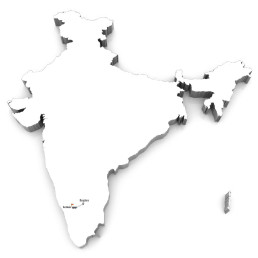
Jnana Yajna 73

Year & Dates:
September 03, 1960 to September 24, 1960

Yajna Topic:
Shrimad Bhagavad Gita- Chapter 2

Place:
Kozhikode, India.
Kozhikode, which had the fortune of hosting Pujya Gurudev’s 9th Jnana Yajna on Aitareya Upanishad as early as in March 1955, had to wait more than five long years for His next Jnana Yajna in its beautiful coastal surroundings. When Pujya Gurudev agreed to conduct His 73rd Jnana Yajna there on the overarching second chapter of Shrimad Bhagavad Gita, the people were exuberant.
Pujya Gurudev arrived at Kozhikode on the auspicious tenth day of Onam that year, on September 3, 1960. The whole of Kerala was in a festive spirit after a bountiful harvest as it welcomed the New Year as per the Malayalam calendar. Marking the return of Mahabali, the great devotee of Mahavishnu who surrendered to the Vamana Avatara, Onam is well-known for its Pookkalam (rangolis of flowers) and the sumptuous feast called Onam Sadya. To have Pujya Gurudev share the Onam Sadya was indeed a joyful honor.
With Love and Time For All
After a happy inauguration on the evening of September 3rd, the Gita Jnana Yajna began in full earnest in the large Hall of Sri Narayana Guru before another enthusiastic congregation of seekers. Every evening, half an hour before Pujya Gurudev’s main discourse in English, Miss. Parukutty, the secretary of the yajna committee, gave a synopsis of the previous evening’s discourse in Malayalam. Braving the heavy rains, the audience attended the yajna to listen to Pujya Gurudev expound on the verses that sketched the ‘Yoga of Action, the ‘Path of Love,’ and the ‘Path of Renunciation’ as presented in a glorious synthesis of the Sankhya Yoga of the exemplary chapter 2 of the Gita.
The morning discourses on Atma Bodha were held in another venue called the Besant Hall. Because of the inclement weather and Pujya Gurudev’s ill-health, the features of the Laksharchana and the yatra had to be canceled. However, the people of Kozhikode enjoyed an extra day on September 25th with Pujya Gurudev as He delivered a civic address that evening before leaving to Guruvayoor enroute to Ernakulam.
By 1960, Pujya Gurudev’s schedule was packed and showed no signs of letting up. In the few days between two successive Jnana Yajnas, Pujya Gurudev had made it a practice to complete important activities overseeing the growing wings of the Mission as well as monitoring the preparations for the upcoming Sandeepany Sadhanalaya in Mumbai. Thus, in that precious window of time after the 73rd yajna, Pujya Gurudev made the trip to Ernakulam to visit Kochu Narayani Amma, the aunt who raised Balakrishna Menon and whom Pujya Gurudev revered as His mother.
The way the frail Kochu Narayani Amma embraced the commanding sage and how Pujya Gurudev responded with playful banter to her anxious enquiries about His health warmed the hearts of all the devotees in Ernakulam. Pujya Gurudev spread much cheer in that home and refreshed His mother’s spirits. He enquired about the wellbeing of those who clamored for His attention, caring equally for the ordinary and the influential. In that trip to Ernakulam, Pujya Gurudev kindly encouraged His dear, young devotees of the Chinmaya Balavihar group, reveling in their delightful stories and Gita chanting. He also blessed a Kathakali performance with His presence. Effortless was His love that He gave so abundantly wherever He went.
Photo Gallery

“Think,” Says Pujya Gurudev
The Transcendental Truth can be explained only in terms of the limited and the finite or else the students, who have no experience of the beyond, will not be able to conceive of or apprehend the Absolute and the Eternal. When a traveler in a distant clime discovers a beautiful bird of wondrous plumage, when he comes back to his own native land, in order to explain the beauty which he saw, he will have to talk to his friends in terms of the birds’ plumage that are native to folks of his native land. The unseen is explained always in terms of the seen, and thereby the unknown becomes fully indicated rather than defined; for, any unknown quantum merely defined in itself is as unknown as without the definition.
Similarly, here the Changeless, Immutable Self is being described by Lord Krishna in terms of the mutable and ever-changing world which is very familiar to Arjuna and all people like us. In the world-of-change objects come to their annihilation either through instruments of death or are consumed by fire or destroyed by water or dried up by air. These are the various means and methods by which the objects of the world come to their destruction. All these means are declared as impotent in bringing about the destruction of the Self.
From Tyagi Magazine
Watch Your Words!
Effective communication requires sensitivity to the audience’s reaction and understanding. A lack of empathy leads to disconnect and repels others, causing unhappiness and unrest. True mastery lies in remaining unperturbed by external influences, withdrawing from attachment effortlessly like a tortoise retracting into its shell at the hint of danger.
Jnana Yajna 72

Jnana Yajna 72

Year & Dates:
August 07, 1960 to August 31, 1960

Yajna Topic:
Shrimad Bhagavad Gita- Chapter 3

Place:
Bengaluru, India.
Bengaluru had already hosted seven jnana yajnas of Pujya Gurudev’s but its spiritual appetite was far from being whetted. So, on the inaugural day of August 7, 1960, the large pandal already felt inadequate as thousands of seekers rushed for a spot in the front row to listen to Pujya Gurudev once again. At 6:20 pm, He strode in like a spiritual colossus with His Highness, Maharaja Sir Mohan Shamsher Jung Bahadur Rana of Nepal. After the Elayaraja of Travancore and the Chief Minister of Mysore, Sri B. D. Jatti joined Pujya Gurudev on the stage, the 72nd Jnana Yajna opened on a regal note. The Rana of Nepal appreciated how the third chapter of Shrimad Bhagavad Gita was an apt choice by Pujya Gurudev, since it would disclose the glorious secret of action that would benefit the sizable population of factory workers in Bengaluru.
Karma with the Right Motive
Wondering if he even had the qualification to inaugurate Pujya Gurudev’s Gita Jnana Yajna, the Chief Minister Shri B. D. Jatti, said, “If, as stated in the Gita Dhyana shloka, the Upanishads are the cow, Arjuna is the calf and Vasudeva is the cowherd, then Swami Chinmayananda is the milk-boy who brings the ‘Gita milk’ to our door. In the present Yajna, Swami Chinmayanandaji will discourse on the third Chapter of the Gita which deals with the Path of Right Action or Karma Yoga. It is a Chapter in which Lokamanya Tilak found the quintessence of the Gita. I am sure that since action is the very essence of life, we are all eager to know what exactly is the path of Right Action.”
After three reverberating chants of Om, Pujya Gurudev began, “Man cannot remain without acting. Act he must, rightly or wrongly. On analysis we find that action is propelled by thought, good or bad. As one thinks, so he acts. Action remaining the same, we call it good or bad according to the thought and motive behind the limbs of action.” He outlined how actions differ in their qualities and urged aspirants to rise above selfish motives to achieve the perfection that brings glory to all.
From August 8th morning, Pujya Gurudev carried the audience of Bengaluru to an added realm of bliss when He brought out the extraordinary wisdom of Kathopanishad in another huge yajnashala constructed in Kaadu Malleshwara. He began His upanishadic discourse saying that religion, rightly pursued, beautified the individual and uplifted the society.
The yatra for the 72nd yajna was to Srirangapatna and Melkote, on the 27th August 1960.
Boarding nine buses and a fleet of cars all adorned with the fluttering saffron Om flags, about 400 devotees followed Pujya Gurudev who explained how a yatra is a reflective journey of utter simplicity and devotion away from the mundane. The hearts of the devotees were in ecstasy with the satsangas with Pujya Gurudev, their holy dip in the Pashchimavahini river, and worship at the Lord Ranganatha temple at Srirangapatna and Lord Narasimha at Melkote temple. Throughout the yatra as in His yajnashala, Pujya Gurudev showed how actions become divine when dedicated to an altar.
Photo Gallery

“Think,” Says Pujya Gurudev
It is obvious that the productivity that is dormant in any situation can be invoked only by man’s sincere efforts. This potential which generally lies dormant everywhere is the Deva to be cherished by the worker through the Yajna activities, and certainly, it is sure that the Deva will manifest in turn to cherish or to bless the worker. “Thus cherishing one another, man shall gain the highest good,” is the Divine intention, in the mind of the creator, says Krishna in this stanza.
This Law of Seva is faithfully followed by every sentient and insentient member of the cosmos instinctively. Man alone is given the freedom to act as he likes and to the extent he disobeys this Universal Law of Sacrifice, Yajna, to the extent he comes to suffer, not because there are no joy content in things and situations, but because he with his arrogant and egoistic actions brings a discord in the harmony of the existence around him.
From Tyagi Magazine
No Guru, No God can help You!
True goodness comes from personal choice and effort, not merely external influence. Teachers and mentors can offer guidance and nourishment of positive thoughts, but true transformation requires internal digestion and assimilation of these teachings. Superficial changes do not cleanse the inner self; true beauty in action stems from a deep, inner transformation.
Jnana Yajna 71

Jnana Yajna 71

Year & Dates:
July 13, 1960 to August 03, 1960

Yajna Topic:
Shrimad Bhagavad Gita- Chapter 13

Place:
Secunderabad, India.
The story of the 71st Jnana Yajna began with a happy rickshaw ride for Pujya Gurudev. Though He was scheduled to arrive on July 12, 1960, a day before the inauguration of the yajna, He took a flight on July 11th to Hyderabad’s Begumpet airport to avoid delay due to a central government workers’ strike. The airport staff were surprised to see Pujya Gurudev step out alone with no huge welcoming crowd around him. But Pujya Gurudev nonchalantly traveled by the shuttle out of the airport and then enjoyed a quiet rickshaw ride to the Anasuya Villa where He would usually stay. He even went to Secunderbad that evening to inspect the yajnashala, utterly surprising the organizers. Not stopping with that, on July 12th morning, He affectionately went back to the same airport to enable the planned traditional Purna Kumbha welcome and bring joy to the gathered crowds! That sweet prelude is just one example of how Pujya Gurudev was untouched by the fanfare around Him.
At Ease and Always Inspiring
The 71st Jnana Yajna held at Keyes High School started with a stirring welcome by Sri Ramesh Chandra Chowdri and an inaugural address by Sri Kaleshwar Rao, Speaker of the Andhra Pradesh Assembly. Urging the audience to think about intellectual evolution which included scriptural knowledge, Pujya Gurudev pointed out: “We are now in the scientific age. We want to know the scientific basis of every object. Yet the scientific age says we do not want religion. That is not a scientific approach.” His evening discourses on the 13th chapter of Gita was a thorough analysis of what constituted the field of experiences and who the Knower of the field was. In the morning sessions from July 18th, Kenopanishad drew hundreds of seekers; Pujya Gurudev completed His discourses on that contemplative text and then continued teaching until August 3rd about the significance of Om and the different personality layers that veil Consciousness.
On July 30th, 450 devotees boarded 9 buses and three cars with disciplined eagerness for the spiritual yatra to Nagarjuna Sagar, about 3 hours away from Secunderabad. Even before the yajna’s inauguration, Pujya Gurudev had visited Nagarjunasagar with the Raja of Muktyala. It was a place of scientific progress, natural beauty, and cultural worth. At the scenic site, a new dam across the perennial river Krishna was being constructed to become the world’s largest masonry dam, and the Nagarjuna Konda in the middle of Nagarjuna Sagar which had ancient Buddhist excavations was a thought-provoking venue.
The late night satsang, the early kirtans, and the Avabhrta Snaana in the bathing ghats near the ruins of an ancient Shiva temple refreshed the spiritual aspirations of all. The marvel of the architectural carvings of Lord Buddha, the wonder of the learning that happened in that ancient university of Nagarjuna, and the bliss of a midday satsanga with Pujya Gurudev under a neem tree – the devotees returned with memories to uphold for a lifetime.
When the 71st Jnana Yajna concluded on August 4th, along with the sacred sprinkles of the Ganga waters, each seeker received the yajna prasad booklet – “Vedanta, a bird’s eye view,” indicating how Pujya Gurudev wanted to equip all with a higher perspective.
Photo Gallery

“Think,” Says Pujya Gurudev
This realization of the Self in its pure nature, undressed of all its matter envelopments, is the final goal of spiritual seeking, and there is more than one path prescribed for this Divine achievement. Integration of a human personality must start from the point where an individual finds himself to be. No education can be successful unless the students are given graded lessons.
A totally disintegrated individual must also be given a path that he can easily follow with us restless equipment. Spiritual unfoldment cannot take place merely because of an intellectual appreciation of the theory of perfection. Evolution can actually take place only when a corresponding change in the very subjective life is accomplished. Therefore, an active, intelligent and enthusiastic participation of the seeker in controlling, directing and re-educating his own thought-life is necessary. Hence the difficulty in accomplishing the inward spiritual unfoldment in every individual.
The great scientists of the past, discovering ways of evolving the entire mankind constituted of different types, had evolved various parallel roads all leading to the same goal. Each path is the fittest for the one who is walking in it. No path can be said to be a nobler one than the others. In a Medical shop there are different medicines; and each one serves a definite type of patient, and the medicine prescribed for a given disease is the fittest medicine for that patient so long as he continues in his present ailment.
From Tyagi Magazine
Rewire the way you Think!
Our sense of happiness or unhappiness is a result of the quality of thoughts in the mind, shaping our ego. Like sunlight reflecting in water, our self-perception fluctuates with the state of our thoughts, but our true nature as pure consciousness remains unchanged. Recognizing this empowers us to transcend the fluctuations of joy and sorrow, mastering our experiences.
Jnana Yajna 70
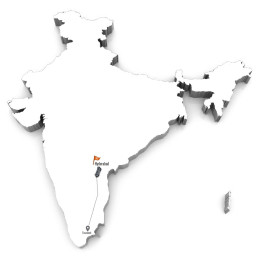
Jnana Yajna 70

Year & Dates:
May 17, 1960 to June 07, 1960

Yajna Topic:
Mundakopanishad

Place:
Hyderabad, India.
The word “Mundaka” brings up the picture of a young disciple with a shaven head sitting in an ashram at the revered Feet of his Guru. However, the Mundakopanishad which belongs to Atharva Veda is not only for the spiritual initiates and renunciates. The Upanishad’s 64 verses hold the great wisdom that will “shave away” the spiritual ignorance and reveal the Highest Knowledge to all sincere seekers. Taught by Sage Angiraa to the prosperous and dharmic householder, Shaunaka, this enlightening upanishad which opens extolling the Guru Parampara, was the topic chosen for Pujya Gurudev’s 70th Jnana Yajna at Hyderabad.
The Andhra Yuvathi Mandali Hall was blessed to be the yajnashala for the third time. While there was the inclination to construct a pandal on open grounds to accommodate the ever-increasing crowds, the organizing committee decided on the Hall to avoid interruptions by rain.So, on the evening of June 17, 1960, the pious refrain of the Maha Mantra welcomed all into the Andhra Yuvati Mandali Hall.
Systematic and Sublime
When Pujya Gurudev arrived at the entrance to the yajnashala at exactly 6:30 pm, Sri P. V. G. Raju, then Minister for Health, Andhra Pradesh, who inaugurated that yajna was waiting respectfully. Sri Daulat Rai, the president of Chinmaya Mission Hyderabad, promptly hoisted the Om flag, and the 70th Jnana Yajna’s inaugural ceremony began with the Chinmaya touch of punctuality that His yajnas stood for.
In His inaugural address, Sri. Raju sketched the struggle of a war-weary, progressive world and the questions that plagued it: “ ls there a positive way of arriving at the truth? Can we get light and guidance to lead us towards the goal of life? I believe that it is through the systematic revival of our ancient spiritual knowledge that we can move forward.”
A champion of spiritual revival, logical and scientific, Pujya Gurudev began the yajna devoting two days to the purpose, scope, and fundamentals of Upanishads. The admiring audience of Hyderabad grew in number each day and, as predicted, the hall was inadequate; the sea of seekers spilled over the galleries, the two wings of the hall, and the verandas. After a week, Pujya Gurudev directed that the evening discourses would move outside the hall. Mesmerized by His commanding voice and masterly exposition, even the breeze moved soft and cool, providing the keen seekers the perfect ambience to listen and meditate on that Brahma Vidya.
Pujya Gurudev ‘s morning classes on the most sublime second chapter of the Gita at the Liberty Gardens was in the idyllic setting under the fully-ripe mango trees. Occasional showers shifted the study indoors to the nearby Balaji Bhavan hall and Pujya Gurudev enthralled a bigger crowd on the glory of a Sthitaprajna at the main Mandali Hall. On May 29th, a Laksharchana of Vishnu Sahasranama transported all to a realm of rapturous devotion. The yatra to Yadagiri Gutta, to the ancient temple dedicated to Sri Lakshmi Narasimha Swami, was a journey to cherish for the 350 devotees.
When Pujya Gurudev concluded Mundakopanishad on June 8th and sanctified the audience with the Ganga waters, the thousands who gathered had an unforgettable glimpse at the Highest Knowledge that could remove the knots of ignorance and bestow lasting liberation.
Photo Gallery

“Think,” Says Pujya Gurudev
The two birds, the real I and the false-I, live in one and the same tree, the body. The ego, in its delusions, goes on peaking at the hanging fruits and comes to suffer joy or sorrow, satisfaction or dis-satisfaction, according to the taste of the fruits packed. Some are ripe, some are unripe; the ripe ones are sweet, the unripe ones are sour. But, the other bird who all alone remains in undisturbed tranquility merely goes on witnessing the joys and sorrows of the bird busy with the fruits!
Here, the fruits are the Karmic fruits-the reactions of one’s own past actions. The past Karmas act on us only when we identify ourselves with our matter-envelopments, and, through them, with the world outside. An outer circumstance or an inner mental attitude cannot in itself give us either joy or sorrow, unless we get deludedly attached to it. The witnessing bird, though it lives in the same tree, comes to suffer neither the sourness nor the sweetness, because it has no desire to taste the hanging fruits, nor does it entertain any hopes to gain happiness from those fruits. It only goes on witnessing.
To remain as a pure witness rooted in our own Real Nature, as the All-perfect All-Blissful Pure Consciousness, is to transcend all pains, limitations and sufferings.
From Mundakopanishad Yajna Prasad
This is the Undying Truth!
The luminous essence of Consciousness pervades all, transcending forms and limitations. It remains unborn and undying, witnessing the activities of the body and mind. This ultimate Reality, beyond creation and destruction, is the source from which the world emerges.
Jnana Yajna 69
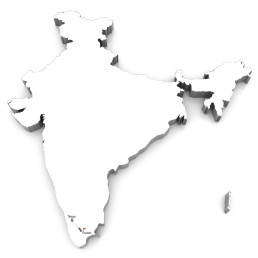
Jnana Yajna 69

Year & Dates:
April 17, 1960 to May 08, 1960

Yajna Topic:
Shrimad Bhagavad Gita- Chapter 3

Place:
Tirunelveli, India.
The skies over Tirunelveli seemed to have watched the excitement of a grand, bright, and artistic pandal springing up in the huge quadrangle of the M. D. T College High School. From the carefully planned car parking facilities to the thoughtfully decorated dais, the thrill of Pujya Gurudev’s Gita Jnana Yajna seemed to have woken up the heavy clouds. So, on the evening of April 17, 1960, just before the inaugural ceremony, a rainstorm accessorized with thunder and lightning decided on its own opening act. The result drenched the carefully sanded floor of the yajnashala, leaving no time for the agonized organizers to find an alternative seating plan. Calm and cheerful, Pujya Gurudev inspected the pandal, invoked the Grace of Bhagavan Shiva at the Nellaiappar temple, and observed the Om flag open up against the rumbling horizon. When Sri I.A. Chidambaram Pillai, the president of the yajna committee, began his welcome address, he was surprised to notice the fully packed audience inside the soaked pandal.
Doing with Dynamic Dedication
Warmed and inspired by Pujya Gurudev’s introductory talk that evening, the audience forgot the discomfort of sitting on the wet grounds. When they heard the promised blessings of Bhagavad Gita from the Master, they were drawn into a higher spiritual orbit where they would be energized for the next 21 days.
Pujya Gurudev declared how Bhagavad Gita was a forever relevant, divine exposition on a vital, vibrant technique of living. He eloquently sketched the background of the Gita where the Divine Charioteer becomes the skillful boatman, Keshava, to ferry Arjuna out of his stormy confusions. In His inimitable style, using the language of commonplace life, He effortlessly took the listeners of all backgrounds to the highest common factor of cooperative action, motivated production, and shared growth as advocated in Karma Yoga. He stressed that work is worship, and alerted the attentive audience how actions get tainted by anxiety, fear, attachment, and selfish motives.
Pujya Gurudev’s sheer logic and poetic power of expression stimulated the aspirants to examine how the two enemies of desire and anger cause havoc, sway the senses, cloud the mind, and render the intellect ineffective. His Jnana Ganga in Tirunelveli was in spate, cleansing the outlook of thousands who came with faith and fervor. The Gita in the evenings and His Upanishad classes in the mornings inundated the temple town with surging spirituality.
To ensure that both Jnana and Karma are always divinized, Pujya Gurudev arranged for the powerful Laksharchana on May 1, 1960. The yajnashala was transformed into a resplendent altar of Bhagavan Krishna as people streamed in all day offering flowers through ten rounds of the Sahasranama chanting by ten pandits. Pujya Gurudev explained how the ten pandits represented the ten senses. He described the intricate meaning behind offering offers during archana: “Watch the hand when it picks up flowers. The fingers are brought together, and they face down. How clearly and perfectly this posture symbolizes the human mistake of gathering vasanas – the senses collect and go downward, and the personalities fall. When they face upward, the vasanas are thrown out; thereby, ‘exhausting’(vasanas) becomes easy and possible.”
Though His body had to submit to a high fever for a couple of days, Pujya Gurudev concluded the 69th Jnana Yajna on May 8th with unabated dynamism personifying how the highest form of action is a liberating art and an indisputable science.
Photo Gallery

“Think,” Says Pujya Gurudev
The whole world of cosmic powers and nature’s phenomena function instinctively in the service of all. Even before life could appear on the face of the earth, the elemental forces had prepared the field with their constant activities performed in the sacred spirit of dedication. Even when life developed and multiplied, at all levels, we can easily recognise different degrees of Yajna-activities, which keep up the harmonious growth of existence.
Poetically the same idea becomes this pregnant stanza in the Geeta. The Creator created the world along with the spirit of service and the capacity for sacrifice. As it were, the Creator declared, “By this spirit of self-sacrifice shall you multiply: this shall be the milch-cow of your desires.” Kamadhenu is a mythological cow supposed to have belonged to Sage Vashishta from which all our desires can be milked out. The term, therefore, means only that no achievement is impossible for man if he knows how to act in the discipline of cooperation, and if he is ready to bring forth into his activities the required amount of non-attachment and spirit of sacrifice.
From Tyagi Magazine
Why are you born Human?
Human existence is shaped by vasanas, determining our experiences and environments. Understanding this, one can accept both suffering and happiness without egoic attachment, recognizing the unfolding of vasanas as the essence of life’s journey. Surrendering to this understanding frees one from the illusion of personal agency.
